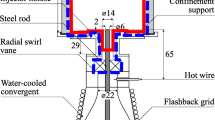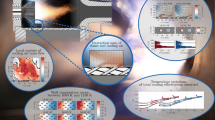Abstract
The interaction of a stoichiometric, laminar premixed methane/air flame with a coolant jet is investigated using two-dimensional fully resolved simulations (FRSs). The flame is forced at the inlet with velocity modulation and the coolant is injected from a cooling hole located on the wall at the same temperature as the premixture. FRS cases featuring a combination of blowing ratios, forcing frequencies, position of the cooling hole and the coolant type (air and \(N_2\)) are studied to understand the effects of these parameters on flame dynamics and CO emissions. The results show a negligible impact of the forcing frequency on the exhaust CO emissions. However, increasing the blowing ratio and the cooling hole streamwise location both increase the exhaust CO emissions. Using air instead of nitrogen as the coolant reduces the CO emission by providing additional oxygen and therefore enhancing CO oxidation. Furthermore, analysis of the CO mass fraction in the near-wall, post-cooling hole region shows a strong dependence on the local temperature and the mixture fraction used as a measure of dilution. CO mass fraction—temperature (\(Y_{CO} - T\)) scatter plots reveal the same trends as those of one-dimensional (1D) freely-propagating flames at different equivalence ratios up to a limit, identified using a progress variable based on the \(CO_2\) mass fraction. The results of this work highlight the potential pathways for modelling the near-wall CO mass fraction in effusion cooled combustors.




















Similar content being viewed by others
References
Andrews, G.E., Kim, M.N.: The influence of film cooling on emissions for a low \(NO_x\) radial swirler gas turbine combustor. In: ASME Turbo Expo Paper 2001-GT-0071 (2001)
Baum, M., Poinsot, T.J., Haworth, D.C., Darabiha, N.: Direct numerical simulation of \(H_2\)/\(O_2\)/\(N_2\) flames with complex chemistry in two-dimensional turbulent flows. J. Fluid Mech. 281(1), 1–32 (1994)
Bilger, R.W.: The structure of turbulent nonpremixed flames. Symp. (Int.) Combust. 22, 475–488 (1988)
Brouzet, D.: Investigation of direct combustion noise in turbulent premixed jet flames using direct numerical simulations. Ph.D. thesis (2020)
Correa, S.M.: Carbon monoxide emissions in lean premixed combustion. J. Propul. Power 8(6), 1144–1151 (1992)
Ducruix, S., Durox, D., Candel, S.: Theoretical and experimental determinations of the transfer function of a laminar premixed flame. Proc. Combust. Inst. 28, 765–773 (2000)
Gordon, R.L., Masri, A.R., Pope, S.B., Goldin, G.M.: Transport budgets in turbulent lifted flames of methane autoigniting in a vitiated co-flow. Combust. Flame 151, 495–511 (2007)
Gruber, A.: Direct numerical simulation of turbulent combustion near solid surfaces. Ph.D. thesis (2006)
Gruber, A., Sankaran, R., Hawkes, E.R., Chen, J.H.: Turbulent flame-wall interaction: a direct numerical simulation study. J. Fluid Mech. 658, 5–32 (2010)
Jainski, C., Rißmann, M., Böhm, B., Janicka, J., Dreizler, A.: Sidewall quenching of atmospheric laminar premixed flames studied by laser-based diagnostics. Combust. Flame 183, 271–282 (2017)
Jiang, B., Gordon, R.L., Talei, M.: Head-on quenching of laminar premixed methane flames diluted with hot combustion products. Proc. Combust. Inst. 37, 793–801 (2019)
Jiménez, C., Kurdyumov, V.N.: Propagation of symmetric and non-symmetric lean hydrogen-air flames in narrow channels: influence of heat losses. Proc. Combust. Inst. 36, 1559–1567 (2017)
Jimenez, C., Cuenot, B., Poinsot, T., Haworth, D.: Numerical simulation and modeling for lean stratified propane-air flames. Combust. Flame 128, 1–21 (2002)
Jiménez, C., Haghiri, A., Brear, M.J., Talei, M., Hawkes, E.R.: Sound generation by premixed flame annihilation with full and simple chemistry. Proc. Combust. Inst. 35, 3317–3325 (2015)
Kee, R., Rupley, F., Miller, J., Coltrin, M., Grcar, J., Meeks, E., Moffat, H., Lutz, A., Dixon-Lewis, G., Smooke, M., Warnatz, J., Evans, G., Larson, R., Mitchell, R., Petzold, L., Reynolds, W., Caracotsios, M., Stewart, W., Glarborg, P., Wang, C., Adigun, O.: CHEMKIN-PRO 15131. Reaction Design, San Diego (2013)
Kosaka, H., Zentgraf, F., Scholtissek, A., Bischoff, L., Häber, T., Suntz, R., Albert, B., Hasse, C., Dreizler, A.: Wall heat fluxes and \(CO\) formation/oxidation during laminar and turbulent side-wall quenching of methane and DME flames. Int. J. Heat Fluid Fl. 70, 181–192 (2018)
Krewinkel, R.: A review of gas turbine effusion cooling studies. Int. J. Heat Mass Transf. 66, 706–722 (2013)
Lefebvre, A.H., Ballal, D.R.: Gas Turbine Combustion: Alternate Fuels and Emissions. CRC Press, Boca Raton (2010)
Moser, R.D., Kim, J., Mansour, N.N.: Direct numerical simulation of turbulent channel flow up to \(Re_{\tau }\)=590. Phys. Fluids 11(4), 943–945 (1999)
Palulli, R., Talei, M., Gordon, R.: Unsteady flame-wall interaction: impact on \(CO\) emission and wall heat flux. Combust. Flame 207, (2019)
Palulli, R.: Direct numerical simulation of flame-wall interaction and flame-cooling air interaction. Ph.D. thesis (2020)
Panitz, T., Wasan, D.T.: Flow attachment to solid surfaces: the Coanda effect. AIChE J. 18(1), 51–57 (1972)
Poinsot, T.J., Lele, S.K.: Boundary conditions for direct simulations of compressible viscous flows. J. Comput. Phys. 101, 104–129 (1992)
Poinsot, T.J., Haworth, D.C., Bruneaux, G.: Direct simulation and modeling of flame-wall interaction for premixed turbulent combustion. Combust. Flame 95, 118–132 (1993)
Razdan, M.K., McLeroy, J.T., Weaver, W.E.: Retrofittable dry low emissions combustor for 501-K industrial gas turbine engines. In: International Gas Turbine and Aeroengine Congress and Exposition. American Society of Mechanical Engineers Paper 94-GT-439 (1994)
Rivera, J.E., Gordon, R.L., Brouzet, D., Talei, M.: Exhaust \(CO\) emissions of a laminar premixed propane—air flame interacting with cold gas jets. Combust. Flame 210, 374–388 (2019)
Schuller, T., Durox, D., Candel, S.: A unified model for the prediction of laminar flame transfer functions: comparisons between conical and V-flame dynamics. Combust. Flame 134, 21–34 (2003)
Scrittore, J.J., Thole, K.A., Burd, S.W.: Investigation of velocity profiles for effusion cooling of a combustor liner. In: ASME Turbo Expo Paper GT2006-90532, vol. 129, pp. 518–526 (2006)
Smith, K., Fahme, A.: Back side-cooled combustor liner for lean-premixed combustion. In: International Gas Turbine and Aeroengine Congress and Exhibition. American Society of Mechanical Engineers Paper 99-GT-239 (1999)
Smith, G.P., Golden, D.M., Frenklach, M., Moriarty, N.W., Eiteneer, B., Goldenberg, M., Bowman, C.T., Hanson, R.K., Song, S., William C. Gardiner, Jr., Vitali V. Lissianski, Qin, Z.: GRI-MECH 3.0. URL http://www.me.berkeley.edu/gri_mech/
Willis, J.D., Toon, I.J., Schweiger, T., Owen, D.A.: Industrial RB211 dry low emission combustion. In: International Gas Turbine and Aeroengine Congress and Exposition. American Society of Mechanical Engineers Paper 93-GT-391 (1993)
Acknowledgements
The authors acknowledge the generous support of the European Centre for Research and Advanced Training in Scientific Computation (CERFACS), in providing the authors with the source code for NTMIX-CHEMKIN. In particular, the authors thank Dr. Benedicte Cuenot for her help with this code. This research was undertaken with the assistance of resources and services from the National Computational Infrastructure (NCI), which is supported by the Australian Government. This work was also supported by resources provided by the Pawsey Supercomputing Centre with funding from the Australian Government and the Government of Western Australia.
Funding
This work was supported by the Australian Research Council (ARC) Grant DE180100416 and the University of Melbourne through the Melbourne Research Scholarship.
Author information
Authors and Affiliations
Corresponding author
Ethics declarations
Conflict of interest
The authors declare that they have no conflict of interest.
Supplementary Information
Below is the link to the electronic supplementary material.
Rights and permissions
About this article
Cite this article
Palulli, R., Talei, M. & Gordon, R.L. Analysis of Near-Wall CO due to Unsteady Flame-Cooling Air Interaction. Flow Turbulence Combust 107, 343–365 (2021). https://doi.org/10.1007/s10494-020-00233-y
Received:
Accepted:
Published:
Issue Date:
DOI: https://doi.org/10.1007/s10494-020-00233-y




